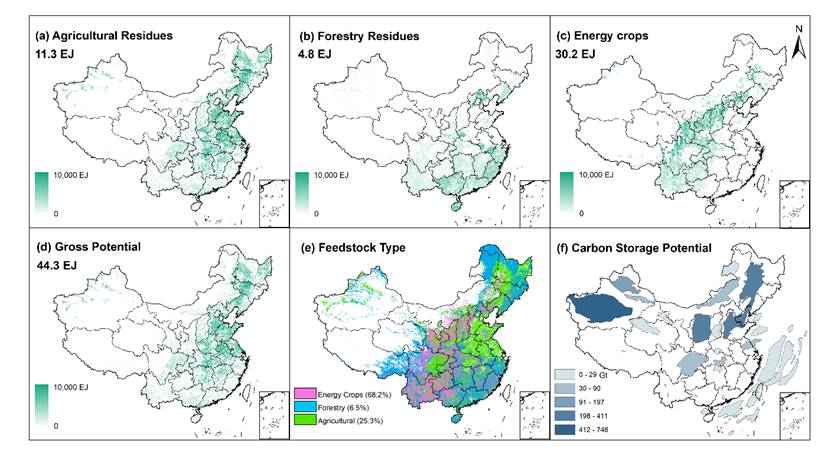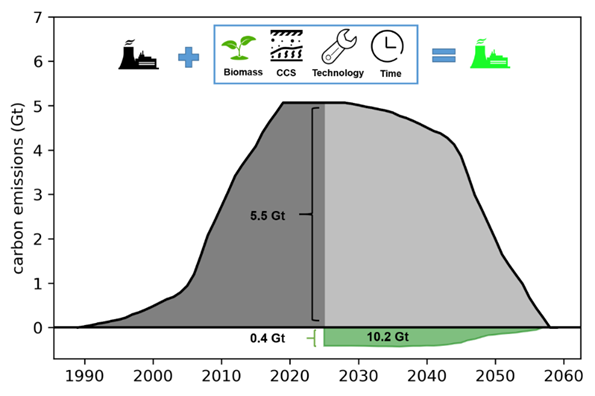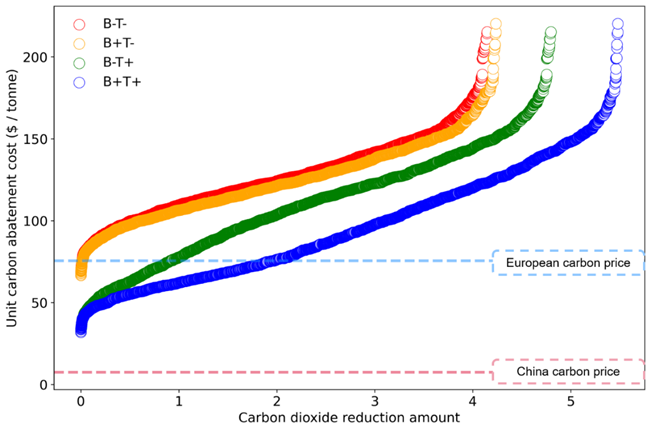The low-carbon transformation of coal power units in China is critical to achieving the 1.5 degree temperature control target of the Paris Agreement and the carbon neutrality target. Biomass and Coal co-firing Power unit with Carbon Capture and Storage (BCP-CCS), as an important negative carbon emission technology, may inspire new ideas for the transformation. As biomass can absorb carbon dioxide and replace fuel, and BCP-CCS can absorb the terminal emissions of coal power units, this technology can avoid the side effects of forced phasing out of coal-fired power, and it is even expected to help the electric power sector achieve negative carbon emissions (besides its own emission reduction, it can also remove carbon dioxide from the air).
On November 3, Associate Professor Cai Wenjia's Research Group of Tsinghua University publishes a paper titled "Alternative Pathway to Phase Down Coal Power and Achieve Negative Emission in China" in Environmental Science & Technology, revealing negative carbon dioxide emission potential of China’s coal power units using biomass and coal co-firing power units with carbon capture and storage (BCP-CCS).
Firstly, this research evaluated the potential of sustainable utilization and development of biomass resources in China, and based on the spatial distribution, installed capacity, remaining operating life and other information of 4536 coal power units in China, as well as the spatial distribution of carbon capture and storage, completed the spatial matching of biomass -coal power units-carbon storage sink under different mixed combustion ratio requirements. Subsequently, this research constructed a comprehensive evaluation framework of BCP-CCS technology's carbon dioxide emissions and the cost per unit of electricity generation in the whole life cycle. This research fully considered the spatial heterogeneity of coal power units, explored the negative carbon emission potential of the China power sector and discussed the key influencing factors on the basis of the simulation evaluation of one plant and one policy.

Fig. 1. Spatial distribution of China’s bioenergy potential and carbon storage potential.
The research results show that if we fully exploit China’s biomass resources (agricultural and forestry residues and marginal land are planted with energy crops) and have a technology breakthrough in the co-firing ratio (0% and 100% co-combustion ratio can be achieved), China’s coal power units, if reformed as soon as possible, would be able to achieve 0.4 Gt of negative emission in 2025 and 10.2 Gt of cumulative negative emission from 2025 to 2060 (equivalent to China’s CO2 emission in 1 year), as coal power units can realize negative carbon emission until natural retirement once reformed, and China's coal power units are relatively young. 
Fig. 2. Negative carbon dioxide emission potential of China’s coal power units using biomass and coal co-firing power units with carbon capture
and storage (BCP-CCS)
It is pointed out in the research that there are conditions for the coal power sector in China to achieve negative CO2 emission. Only when the biomass resource amount is 1.65 times the existing agricultural and forestry residues, and the biomass and coal co-firing ratio exceeds 70% can coal power units with negative carbon emissions offset the positive emissions of units not suitable for BCP-CCS technology, thus realizing negative carbon emissions in the whole industry. In addition, considering the commissioning time and remaining life of the units themselves, the impact of the postponed retrofit has also been discussed. The results show that, under different scenarios of biomass resource supply and technological breakthrough, the negative emission potential would decrease at a rate of 0.06−0.35 Gt per year of postponement, implying the urgency to retrofit the current units. Besides, the research also evaluated the economy of this technology, demonstrating that under the European carbon price, around 90−1870 (1.9−41%) coal power units would choose to achieve low carbon transformation..

Fig. 3 Carbon dioxide emission reduction curve of China’s coal power units using BCP-CCS technology.
The research has fully considered the supply-demand relationship and spatial heterogeneity of each unit's retrofit, answering the question of under what conditions coal power units have the opportunity to achieve negative carbon emissions, and expand the time dimension, and exploring the cumulative negative emission potential. The research results can offer an alternative solution to the current hot issue of coal power phasing out, and provide a reference for the emission limit of industries with difficulty in emission reduction.
Wang Rui, a doctoral student from the DESS, Tsinghua University, is the first author of this paper, and Associate Professor Cai Wenjia is the corresponding author. The co-authors of the paper include doctoral students Li Haoran, Weng Yuwei and Nie Yaoyu of the research group, postdoctoral doctors Cui Xueqin and Zhang Shihui, Associate Professor Yu Le of the DESS, Tsinghua University, and doctoral students Cao Bowen, Associate Professor Li Wei and doctoral students Lei Zhu of A/Prof. Yu Le’s research group, Professor RoyceWong and doctoral students Li Jin and Song Xinke of Tsinghua University Institute of Environment, researchers Huang Lin, Ma Weidong, Bian Jiang and Zhang Jia of Microsoft Asia Research Institute, Dr. Qi Binbin of China University of Petroleum (Beijing), and Researcher Fu Jingying of the Institute of Geographical Sciences and Resources of the Chinese Academy of Sciences. This research is supported by the National Natural Science Foundation of China, Tsinghua-Rio Tinto Resources Joint Research Center and Microsoft Research Asia.
Full-text link of the paper:(https://doi.org/10.1021/acs.est.2c06004)
Written by Wang Rui